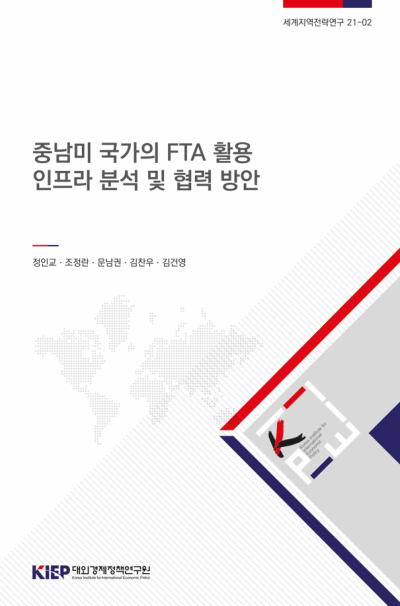Working Papers
PUBLISH
Working Papers
To list

Analysis of FTA Utilization Infrastructure and Economic Cooperation Mechanism between Korea and Latin American Countries
Economic cooperation, Free trade
Author Inkyo Cheong, Jungran Cho, Namkwon Mun, Chanwoo Kim, and Gunyoung Kim Series 21-02 Language Korean Date 2021.12.30
In 2007, when the Korea-US FTA negotiations were concluded, the government of Korea started a program to support the utilization of FTAs by SMEs. Since then, through the enactment of laws and the related regulations, it has established a systematic FTA utilization support system that cannot be found in other countries. Korea’s FTA utilization support system has been modified and supplemented for more than 10 years. FTA utilization support includes providing information on FTA utilization (opening a website or holding education and briefing sessions, etc.), consulting on FTA utilization (preferential tariff, country of origin, FTA business model, etc.), and establishment of FTA utilization infrastructure (origin management system, customs clearance and preferential tariff margins with FTAs), and fostering professional manpower (undergraduate, graduate course, etc.).
No country in Latin America has a comprehensive system to support the use of FTAs. The text of FTAs, the tariff concession schedule, and the rules of origin for goods are presented on the website of the national government (public) institution or the Organization of American States (OAS) FTA Information Center (SICE). Many low-income countries, such as Nicaragua, El Salvador, and Honduras, have a lot of difficulties in promoting the use of FTAs due to poor physical infrastructure including the Internet.
Recently several countries have shown interests in adopting Korea’s FTA utilization support system. Korea, along with Chile and Mexico, has built the world’s widest FTA network, but there are several factors adverse to its export performance such as WTO’s lethargy, COVID-19 quarantine measures, global protectionism, and decoupling of the US and China economy. In order to respond to changes in the global trade environment, it is necessary to enhance the utilization of the existing FTA and to strengthen the FTA policy by negotiating to upgrade the existing FTAs and promoting new FTAs.
This study intends to explore economic cooperation measures to support the use of FTAs among Latin American countries that have concluded FTAs with Korea or have raised the need for a new FTA. A total of 10 countries were selected for analysis, including 4 member states of the Pacific Alliance (Chile, Peru, Colombia, Mexico) and 6 Central American countries (Guatemala, Nicaragua, El Salvador, Honduras, Costa Rica, and Panama).
The conclusion of the FTA negotiations with the MERCOSUR, which is currently underway, is the top priority for Korea’s trade policy with Latin American countries. In the case of the MERCOSUR, since internal policies within the block become a critical factor in the process of negotiations, it is difficult to expect the desired results from economic cooperation without a change in the attitude of the MERCOSUR countries (Brazil, Argentina, Uruguay, and Paraguay) at the regional level toward the FTA with Korea. While many research reports on the necessity and strategy of economic cooperation with the MERCOSUR have already been published, research reports on economic cooperation with small and medium-sized countries in Latin America are rare.
In addition, securing the status of an associate member of the Pacific Alliance (PA), which can have an effect comparable to that of an FTA with Mexico, is an important issue in Korea’s trade policy. This study focuses on research to find ways to strengthen economic cooperation with Mexico, which is not making progress. However, this does not mean to underestimate the importance of economic cooperation with the MERCOSUR countries.
Through transferring Korea’s FTA utilization support system to the Latin American countries in the form of economic cooperation, it is possible to expand economic gains earned from the FTAs with Latin American countries and to raise local interests toward the FTA utilization. The purpose of this report is to select a set of countries of priority for economic cooperation in the transfer of Korea’s FTA utilization support system.
Chapter 2 summarizes the development process and the main contents of Korea’s FTA utilization support system. The enactment of laws and regulations have been described in detail. Based on Korea’s experience, it is necessary to transfer a support system suitable for local conditions in Latin American countries and induce them to develop step by step.
Chapters 3 and 4 try to find the target countries for economic cooperation supporting the use of FTAs and to estimate the effects of economic cooperation. Even if a large number of FTAs have been concluded, it will be difficult for this economic cooperation project to proceed smoothly in the case of countries that do not provide FTA utilization support services to their own companies. With this point in mind, the criteria for selection of priority countries were established. One of the criteria is the impact on the GVC of Latin American countries, based on the reports by the international economic organizations (World Bank 2017, 2018; UNCTAD 2020, etc.) arguing that FTAs not only deepen participation in GVC, but also help economic growth by activating trade in intermediate goods.
In Chapter 5, based on the analyses in Chapters 3 and 4, the target countries for economic cooperation to support the use of FTAs have been selected, and accordingly, the policy issues that should be focused on supporting those countries have been derived. In this study, Mexico, Colombia, and Guatemala have been selected as the priority countries for Korea’s FTA utilization support economic cooperation through an analysis of various aspects such as the FTA utilization support infrastructure, industrial base and structure, and the impact of the project on GVC. Finally, the conclusion and policy implications are given at the Chapter 6.
Sales Info
| Quantity/Size | 206 |
|---|---|
| Sale Price | 10 $ |
 공공저작물 자유이용허락 표시기준 (공공누리, KOGL) 제4유형
공공저작물 자유이용허락 표시기준 (공공누리, KOGL) 제4유형
대외경제정책연구원의 본 공공저작물은 "공공누리 제4유형 : 출처표시 + 상업적 금지 + 변경금지” 조건에 따라 이용할 수 있습니다. 저작권정책 참조
